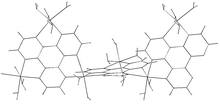Syntheses, crystal structures and magnetic properties of polynuclear 1,4,5,8,9,12-hexaazatriphenylene (hat)-bridged copper(II) complexes
Abstract
Three polynuclear compounds containing copper(II) and 1,4,5,8,9,12-hexaazatriphenylene (hat) as the basic building blocks have been prepared, [Cu4(hat)2Cl8]n·6nH2O 1, [Cu(hat)(H2O)2]n[NO3]2n2, and [Cu2(hat)(H2O)6]n[SO4]2n·2nH2O 3, their crystal structures determined and variable-temperature magnetic susceptibility data measured. The basic building block in 1 is the dinuclear [Cu2(hat)Cl4] entity, two such units being connected to tetranuclear units through relatively strong axial Cu–Cl bonds (out-of-plane di-μ-chloro bridges). Weaker axial Cu ⋯ Cl interactions link the units into a sheet structure. In 2 and 3 hat-bridged copper(II) chains extending along glide planes are present. hat serves as a bis-bidentate ligand in 2 and as a ter-bidentate ligand in 3; in the latter compound one of the copper atoms coordinated to hat does not participate in chain formation. The copper coordination geometries observed in these compounds are square pyramidal and elongated octahedral. hat coordinates either in only equatorial positions to copper (1), or alternates with one chelate in two equatorial positions and another in one equatorial and one axial position (2 and 3). The copper ⋯ copper distance across the hat bridge in 1 is 6.857(1) Å and 3.517(1), 3.600(1) and 3.651(1) Å across the three different di-μ-chloro bridges. In 2 the intrachain Cu ⋯ Cu distance is 6.797(1) Å. Three different Cu ⋯ Cu distances across the hat bridge are found in 3, one of 6.789(1) Å involving two equatorial Cu–N bonds across a pyrazine ring, and two of 7.117(1) and 7.186(1) Å involving one equatorial and one axial Cu–N bond to a pyrazine. Variable-temperature susceptibility measurements on 1–3 reveal the occurrence of weak intramolecular antiferromagnetic interactions between copper(II) ions through bridging hat, the J values being −2.5 (1), −2.1 (2) and −2.4 cm−1 (3). In 1 the interaction across the di-μ-chloro bridge within the tetranuclear entity (J′) is found to be weak and ferromagnetic in character (ca. +0.7 cm−1).


 Please wait while we load your content...
Please wait while we load your content...